- Author: Kathy Keatley Garvey
Countdown 'til UC Davis Picnic Day...
UC Davis will welcome thousands of visitors Saturday, April 16 to its 102nd annual Picnic Day, themed "Cultivating Our Authenticity." You can access the schedule of events here.
It promises to be educational, informative and entertaining.
In the UC Davis Department of Entomology and Nematology, graduate students are organizing numerous displays and activities in Briggs Hall on Kleiber Hall Drive. Director Lynn Kimsey, professor of entomology, and her crew are working on the displays in the Bohart Museum of Entomology, located in Room 1124 of the Academic Surge Building on Crocker Lane.
Three of the traditional exhibits coordinated by the department are nominees for special awards. They are:
- "Little Swimmers and Fly Tying” (Briggs Hall), nominated in the category, "Hidden Treasures"
- "Medical Entomology” (Briggs Hall), listed in the category, "Academic Exhibits" and
- "Real Insects and Mimics" (Bohart Museum of Entomology), "Family Friendly" Exhibit.
An online voting poll, available from 8 a.m. to 10 p.m. on Saturday, April 16, will determine the winners. Visitors may vote at https://orgsync.com/51524/forms/194037. Winning exhibits will be featured on social media pages such as the Picnic Day website, Facebook, Twitter, Instagram, and Snapchat accounts after Picnic Day. They also will be featured next year, in preparation for Picnic Day 2017.
The Briggs Hall open house will be from 9:30 to 4 p.m., and the Bohart Museum open house from 10 to 3 p.m.
Briggs Hall will be the site of a pollination pavilion, maggot art, cockroach races, fly-tying, face-painting, honey tasting, and a bee observation hive, and displays about ants, mosquitoes, aquatic insects and forest insects. The Bug Doctor booth ("The Doctor Is in") will be staffed by faculty and graduate students, while UC Davis forensic entomologist Robert Kimsey, aka "The Fly Man of Alcatraz," and entomology graduate Danielle Wishon will staff the Dr. Death table.
Honey tasting? Visitors can taste these varieties: Peppertree, eucalyptus, almond, sage, sweet clover, and pine "honey," according to Extension apiculturist Elina Niño of the Harry H. Laidlaw Jr. Honey Bee Research Facility.
Also at Briggs Hall, the UC Statewide Integrated Pest Management Program (UC IPM) will give away lady beetles, aka ladybugs, to kids to take home to their gardens. UC IPM also will provide advice on how to manage home and garden pests with environmentally sound methods.
The Entomology Graduate Student Association (EGSA) will be selling its popular insect-themed t-shirts.
At the Bohart Museum, the focus will be on "real insects as mimics." You'll see flies that look like bees--and bees that look like flies. In addition, you can hold and photograph the critters in the live "petting zoo," including Madagascar hissing cockroaches, walking sticks, and rose-haired tarantulas. The gift shop, featuring t-shirts, books, posters, insect collecting equipment, will be open.
Meanwhile, here's a look at some of "The Girls" you'll see: lady beetles (commonly known as ladybugs), Painted Lady butterflies, honey bees, all at Briggs Hall, and a rose-haired tarantula named "Peaches" at the Bohart Museum of Entomology.
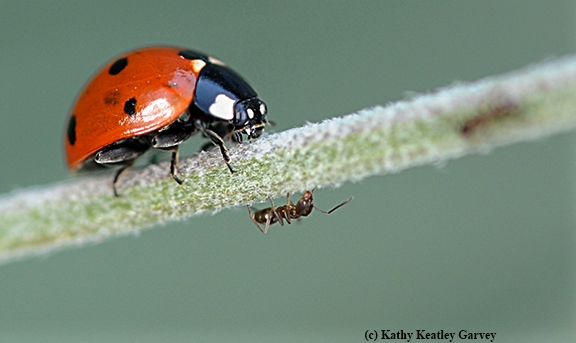

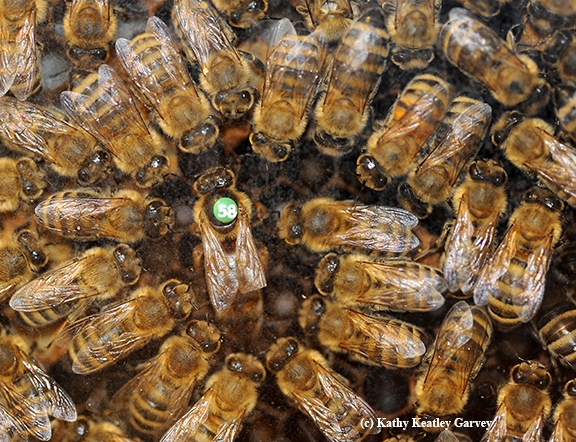
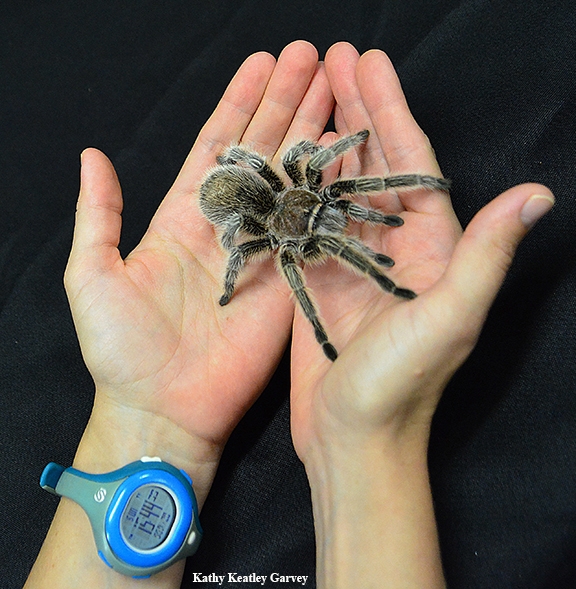
- Author: Kathy Keatley Garvey
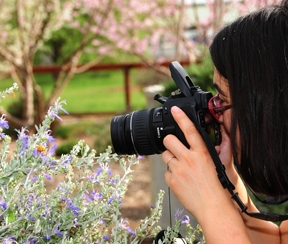
They go together like honey bees on bee balm and bumble bees on tomatoes.
When you attend the 102nd annual campuswide UC Davis Picnic Day on Saturday, April 16, be sure to head over to Briggs Hall, Kleiber Hall Drive, to see the Pollinator Pavilion, which will emphasize the importance of pollinators in both natural environments and food production.
"It is often said that one in every three bites of food we take is dependent on animal pollination," said Pavilion Pollinator coordinator Margaret "Rei" Scampavia, a doctoral candidate in entomology. "While there are some foods that do not rely on animal pollination, many of the tastiest and most nutritious food does. To this end, we have a series of posters demonstrating what a meal might look like with and without foods that benefit from animal pollination."
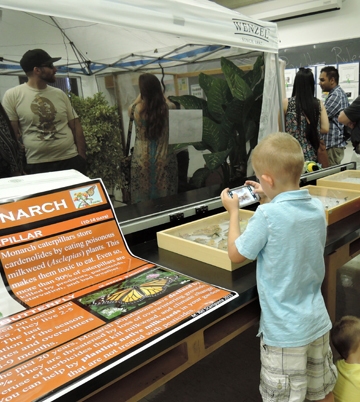
"We are going to have a series of exhibits showcasing pollinator diversity, demonstrating their importance in natural ecosystems and food production, and providing information on what members of the general public can do to help native pollinators," Scampavia said.
"We will have information on a wide variety of animal pollinators, including butterflies, flies, wasps, birds, and even bats. But the majority of the exhibit will focus on the most abundant pollinators: native bees."
The highlight is the walk-in Pollinator Pavillion, an enclosure where visitors can "safely view live pollinators, such as bees, butterflies and flies, up close and in person," the entomologist said. "Younger guests can practice scientific observation by filling out specially provided data sheets. Some of the species present will include: blue orchard bees, Monarch butterflies, Red Admiral butterflies, and Painted Lady butterflies."
Scampavia points out that the European honey bee "is the first thing many people think of when they hear the word pollinator. But in reality, this species is only one of tens of thousands of pollinator species; there are more than 20,000 species of bee besides the honeybee, for example. We hope that visitors to this exhibit will leave with a greater appreciation of the amazingly diverse animals that pollinate flowers."
Last year scores of enthusiastic visitors packed the Pollinator Pavilion. It proved to be one of the most popular, well-crafted, well-designed Picnic Day displays. Another eagerly anticipated event awaits Saturday.
And now there's an urgency.
"Many pollinator species are experiencing alarming declines," Scampavia said. "Monarch butterflies, for example, have declined by over 90 percent in the past ten years. To promote awareness of the plight of the Monarch, we have a series of exhibits with live caterpillars, chrysalises, and adults, which also contain important information about this species and what we can do to prevent further losses. There will also be information about ways to enhance outdoor spaces to promote and sustain healthy wild, native pollinators."


- Author: Kathy Keatley Garvey
What's a picnic without bugs?
Bugs may be uninvited guests at your family picnic, but at the campuswide UC Davis Picnic Day, set Saturday, April 16, bugs are not only invited, but more than welcome. And so are you, your family and friends. In fact, thousands will be attending the 102nd annual celebration, themed "Cultivating Your Authenticity."
The UC Davis Department of Entomology and Nematology is among the departments participating, with activities at Briggs Hall on Kleiber Hall Drive from 9:30 a.m. to 4 p.m., and an open house at the Bohart Museum of Entomology, located in Room 1124 of the Academic Surge Building on Crocker Lane, from 10 a.m. to 3 p.m.
Briggs Hall will be the site of a pollination pavillion, maggot art, cockroach races, fly-tying, face-painting, honey tasting, and a bee observation hive, and displays about ants, mosquitoes, aquatic insects and forest insects. The Bug Doctor booth ("The Doctor Is in") will be staffed by faculty and graduate students, while UC Davis forensic entomologist Robert Kimsey, aka "The Fly Man of Alcatraz," will man the Dr. Death table.
The UC Statewide Integrated Pest Management Program (UC IPM) will give away lady beetles, aka ladybugs, to kids to take home to their gardens. Lady beetles are beneficial insects and will make short work of your aphids. UC IPM also will provide advice on how to manage home and garden pests with environmentally sound methods.
At the pollinator pavilion, you can get up close and personal with butterflies, bees and other pollinators and learn how to protect our pollinators.
At the maggot art table, youths are invited to dip maggots into water-soluble paint and coax them to "create art" on a piece of white paper. Voila! Suitable for framing. And what a great conversation piece!
At the cockroach races, you are invited to cheer for your favorite roach. Everyone has a favorite roach, don't they?
You can also purchase a popular insect-themed t-shirt from the Entomology Graduate Student Association. Think beetles, bees, and wanna-bees.
Mosquitoes? They're invited, too. The Sacramento-Yolo Mosquito and Vector Control District will provide an educational exhibit about mosquito abatement.
Another popular exhibit at Briggs Hall is fly-tying by the Fly Fishers of Davis. They'll show you how to tie a fly.
At the Bohart Museum, the focus will be on "real insects as mimics." You'll see flies that look like bees--and bees that look like flies. In addition, you can hold and photograph the critters in the live "petting zoo," including Madagascar hissing cockroaches, walking sticks, and rose-haired tarantulas. The gift shop, featuring t-shirts, books, posters, insect collecting equipment, will be open.
All in all, it promises to be a picnic that will "bug ya." That's the plan!




- Author: Kathy Keatley Garvey
Clean-shaven it's not. Yet it's a cut above.
For bees, syrphids and butterflies, the long-blooming Jupiter's Beard make the cut.
Centranthus ruber, also known as Jupiter's Beard, Red Valerian, Kiss-Me-Quick, and Keys to Heaven, is a popular drought-tolerant plant that attracts insects like a picnic draws people.
A native of the Mediterranean region, Jupiter's Beard grows wild in California and in several other states, including Arizona, Hawaii, Oregon and Utah.
Cozy up to a Jupiter's Beard, and you're likely to see foraging honey bees, native bees, syrphid flies and butterflies. (And assorted other critters like leafhoppers, lady beetles and spiders.)
The plant was one of the first residents of the Häagen-Dazs Honey Bee Haven, a half-acre bee friendly garden on Bee Biology Road, UC Davis. The garden, installed in the fall of 2009 and operated by the UC Davis Department of Entomology and Nematology, will be the site of a spring open house from 11 a.m. to 2 p.m. on Saturday, April 9. The event, free and open to the public, will feature a noon tour, and other activities, including how to catch, observe and release bees; how to identify bees; and what to plant to attract bees and other pollinators. A bee observation hive is also planned where visitors can see the queen bee, workers and drones.
Then don't forget the campuswide UC Davis Picnic Day on Saturday, April 16. What's a picnic without bugs?
In addition to the scores of the other fun and educational activities on campus, remember the two B's: Briggs and Bohart. You can enjoy entomological events at Briggs Hall, located on Kleiber Hall Drive, and the Bohart Museum of Entomology, located on Crocker Lane.
Among the activities at Briggs: cockroach races, pollinator pavilion, a honey tasting, fly-tying, facepainting, Bug Doctor (The Doctor Is In!), maggot art, medical entomology exhibits, and displays of ants, mosquitoes, aquatic insects and forest insects. The UC Integrated Pest Management Program will give away lady beetles (aka ladybugs) to kids, and hand out information about pests and beneficial insects.
At the Bohart Museum, home of nearly eight million insect specimens, you can get up close and personal with the live "petting zoo," including the Madagascar hissing cockroaches, walking sticks and a rose-haired tarantula named "Peaches." In keeping with the UC Davis Picnic Day's overall theme, "Cultivating Our Authenticity," the Bohart theme is "Real Insects and Their Mimics." Think bees. Think flies. Think about how to tell the difference. Syrphids, especially drone flies, are commonly mistaken for honey bees. Not all floral visitors are bees...


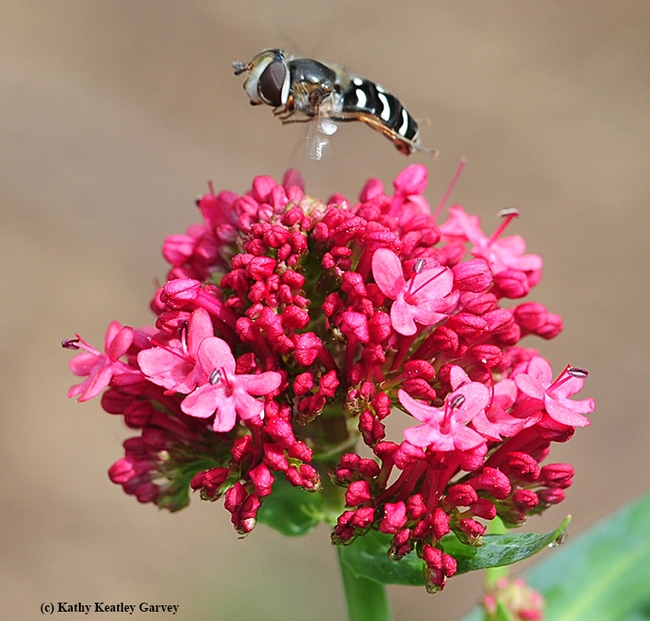
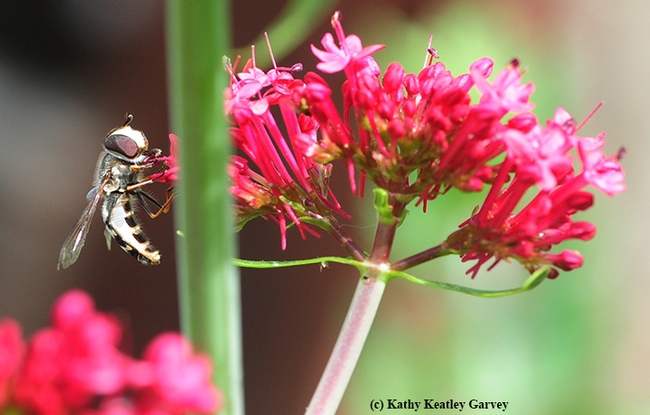
- Author: Kathy Keatley Garvey

How do you begin? Where do you start?
Distinguished Professor James R. Carey of the UC Davis Department of Entomology and Nematology led a class on how to do just that several years ago. Under his direction, UC Davis students crafted a playlist of 11 short videos on insect-collecting.
The project, considered the best-of-its-kind on the Internet, won an award from the 7000-member Entomological Society of America.
The videos are online but if you attend the UC Davis Picnic Day on Saturday, April 18, you can see the continuous loop of videos being played from 10 a.m. to 3 p.m. in Room 122 of Briggs Hall, off Kleiber Hall Drive. Fliers printed with the URL and QR codes also will be available.
The entire series can be viewed in less than 10 minutes. The clips range in length from 32 seconds to 77 seconds.
“So in less than 10 minutes, someone can learn how to make an insect collection,” Carey said. The clips are tightly scripted, with an emphasis on brevity, simplicity and low cost."

Making the insect-collection module was a low tech-low cost operation partly by design. “I wanted production to be ‘low tech' so that anyone who could use a point-and-shoot camera and basic movie-editing software could produce a video clip,” Carey said. ”It needed to be low cost not only because of no funding for the project, but because the basic challenge was to produce a set of high-content-high quality video clips at virtually zero cost."
UC Davis forensic entomologist Robert Kimsey provided the introductory narration for each clip. The students chose MovieMaker software (included in the MS Office package) and Sony Vegas Movie Studio. Paul ver Wey, media production manager of the UC Davis Information Educational Technology's Academic Technology Services, taught them the basics of videography and editing; Wes Nelms gave a tutorial on the use of Vegas Movie Studio
So, stop by Briggs Hall and watch the videos on how to make an insect collection. Or access them online.
All are posted on YouTube and linked to the department's website.
Part 1:
Hand Collecting (32 seconds)
Part 2:
Using an Aspirator (34 seconds)
Part 3:
Ground Collecting (54 seconds)
Part 4:
Aquatic Collecting (58 seconds)
Part 5:
Using Nets (58 seconds)
Part 6:
Killing (51 seconds)
Part 7:
Pinning (43 seconds)
Part 8:
Point Mounting (50 seconds)
Part 9:
Labeling Specimens (48 seconds)
Part 10:
Spreading (77 seconds)
Part 11:
Storage and Display (32 seconds)
The 101st annual UC Davis Picnic Day is expected to draw as many as 100,000 visitors campuswide. The focus is on entomology at Briggs Hall and at the Bohart Museum of Entomology. Briggs Hall includes cockroach races, maggot art, honey sampling, fly-tying, a pollination pavilion and many other activities. The Bohart Museum, located in Room 1124 of the Academic Surge Building on Crocker Lane, is home of nearly eight million insect specimens. On Saturday it will showcase pollination activities and provide many other events under the theme, "The Good, The Bad and the Bugly."




